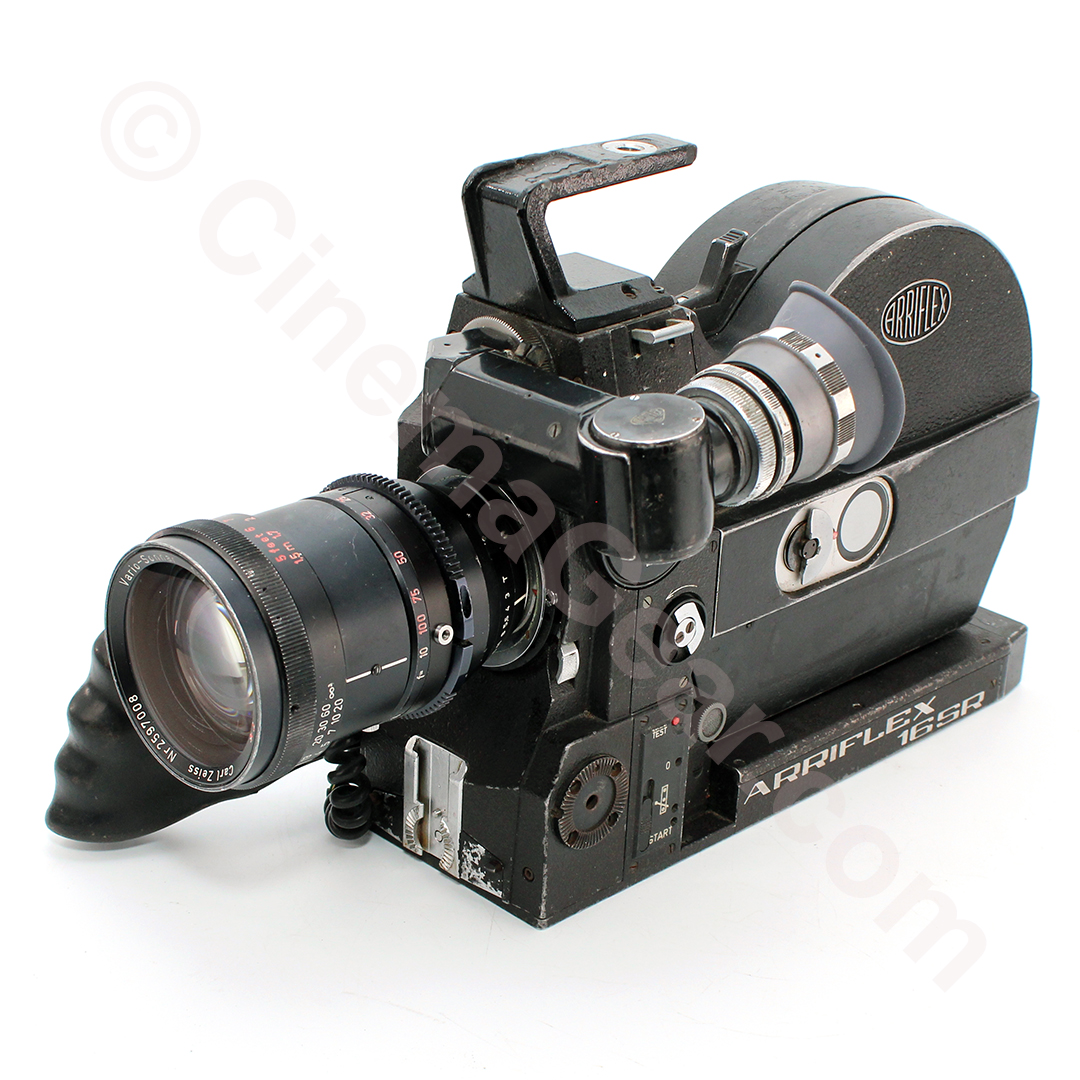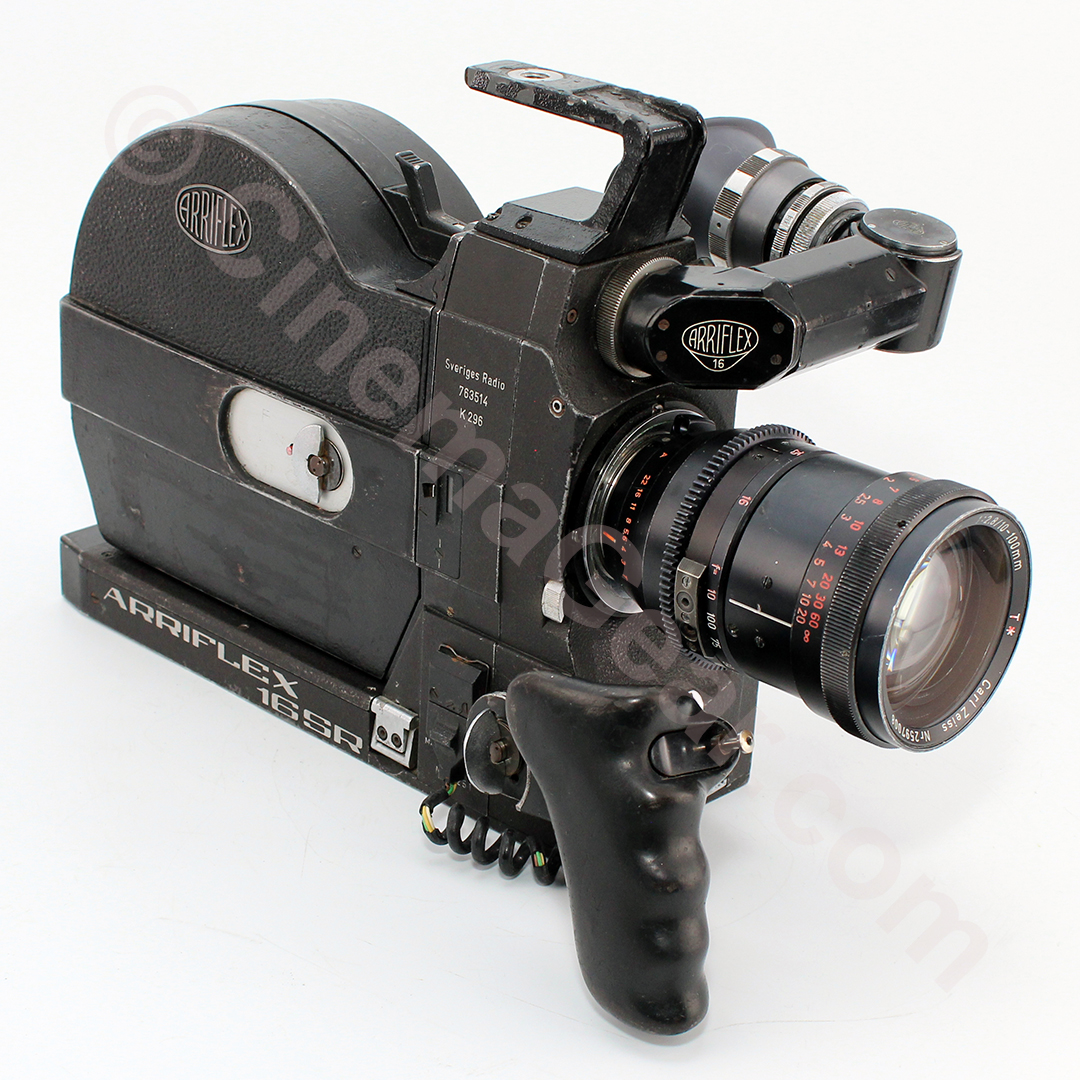
Arriflex 16 SR

$SOLD
Item #C14208
I don't really purchase 16mm equipment anymore, but when I was offered a collection of cameras, including this Arriflex 16SR, that belonged to an old friend and former client, I couldn't say no. Like all the other equipment in this collection, when this ARRI 16SR first arrived, it was extremely dirty and I wasn't sure if it was a running camera. Happily, this 16SR turned out to be a working camera under all of that dirt and grime. A quick cleaning and careful examination of the camera and magazine made me comfortable enough to power the camera up. The camera runs, holds speed, and the magazine seems to work correctly, although the outside film remaining indicator on the back of the magazine is missing its plastic cover. The footage clock on the take-up side of the magazine is in place and working. The on-board light meter seems to work, and I was able to repair the Zeiss 10-100mm zoom enough to make it a usable lens (However, this lens is missing the automatic iris control). We were lucky enough to find an instruction manual online that we will keep with the camera. The camera comes as you see in the photographs, with the camera body, one 400' magazine, pistol grip, and the Zeiss 10-100mm zoom lens. This Arriflex 16SR still has some flaws, but overall, it’s in really nice condition. This camera and lens are offered in as-is, unrestored condition.
The Arriflex 16SR silent reflex camera was debuted at Photokina 1972 in Cologne, Germany to tremendous fanfare, billed as a 16mm "camera for all seasons". However, these cameras were prototypes, and many changes were made before the 16SR was seen again. The new and vastly improved camera was exhibited in 1973 at the 114th SMPTE Conference Equipment Exhibit in New York, and following the conference, at an industry showing in Hollywood. The 16SR represented a sea change in form and function. This spinning mirror reflex camera was designed to fit in the news gathering and documentry world, as well as the feature film world. One of the most notable features of the ARRI 16SR is the symetrical viewfinder that can be adjusted more than 90 degrees in either direction for both left and right side operation. The designers, headed by Erich Kastner, pushed the viewfinder forward 14mm so that the camera could more comfortably rest on the operator's shoulder when shooting handheld. The 16SR is a self-blimped camera with a reported noise output ≤ 31 dBA, suitable for sync-sound filming. It is easily adjustable between 24 and 25 fps, and can be switched to operate at 50 or 60 Hz. It has behind-the-lens filter capabilities, easy to load quick change magazines, and can be used with an on-board battery or powered through its 4-pin XLR accessory plug. Additionally, the 16 SR has an electronic buckle trip, an out of sync warning that can be seen in the viewfinder, and a built-in Pilotone sync generator, along with many other new (at the time) and innovative features. Interestingly, the ARRI 16 SR was used heavily to film the 1976 Winter Olympics in Innsbruck and was praised by operators for its reliability and ease of use.
A Brief History of ARRI
ARRI was founded by August Arnold and Robert Richter in Munich, Germany in 1917. Friends from school, Arnold and Richter already had some experience in the motion picture business, having worked as cameramen and lab technicians. They began their business by building a film copying machine using parts out of an old film projector they purchased secondhand. While sales of their machine were going well, both men continued their work in many aspects of the movie business, including as cinematographers, producers, and lighting technicians. In 1918, they worked on their first film with director Fred Stranz, a western called "Der Schwarze Jack" (or Black Jack).
By 1920 they were producing their own short films, and using the profits to improve their printers. In 1924, Arnold began designing their first motion picture camera, the KINARRI 35, as well as their first lighting equipment. This camera was completed by 1925 and Arnold sent it to Richter in the United States where he had gone to learn about the American film business. Their second camera, the TROPEN, which featured an adjustable rotary shutter, was produced during this time as well. In 1928, the KINARRI 16 was developed for an amateur filmmaking audience, along with a 2nd more advanced model that featured an internal spring wind mechanism. In 1934, with sound films now dominating the market, ARRI developed a portable sound camera, but patent issues prevented it from being sold commercially. Success came soon after though.
In 1937, the ARRIFLEX 35 was released, a revolutionary handheld spinning mirror reflex 35mm motion picture camera that featured a spinning mirrored shutter and a parallax-free erect image viewfinder. This design, which saw many innovations and updates after its introduction, was produced until 1978. The Arriflex 35 is a World War II vintage camera, and saw use by the German military during the war. Some early examples of the ARRI 35 were captured by American troops and brought back to the US. In 1946, ARRI introduced the next generation of this camera, the Arriflex 35 II. So influential was the Arriflex 35 series of cameras, that it was awarded an Academy Award of Merit in 1983 for "the concept and engineering of the first operational 35mm, hand-held, spinning mirror reflex, motion picture camera."
Sources:
- "The New Arriflex 16SR Camera" American Cinematographer, (December 1972): 1364-7, 1416-17.
- "SMPTE Equipment Exhibit: Arriflex 16SR Camera Since Photokina 1972" American Cinematographer, (December 1973): 1548-9, 1587.
- "New From Arriflex" American Cinematographer, (December 1974): 1416-14, 1468-9.
- Lightman, Herb A. "Filming The Olympics" American Cinematographer, (April 1976): 396-9, 434, 438-41, 448.
- Jon Fauer, "The History of ARRI in a Century of Cinema", ARRI, updated 2021, View source.
- "100 Years Inspiring Your Vision", updated 2017, View source.
- Jorge Diaz-Amador, "Camera Profiles - Arriflex 35-II Series," updated 2020, View source.
- Jan Heugel, Arnold & Richter Cine Technik GmbH & Co. Betriebs KG, email message to owner, November 12, 2019.
